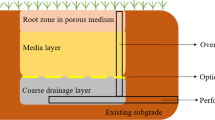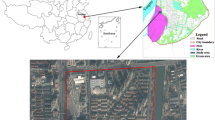Abstract
The low impact development (LID) approach has been recommended as an alternative to traditional stormwater design. Research on individual LID practices such as bioretention, pervious pavements, and grassed swales has increased in recent years. Bioretention cells have been effective in retaining large volumes of runoff and pollutants on site, and consistently reduced concentrations of certain pollutants such as metals. However, retention of certain pollutants such as nitrate–nitrogen and phosphorus has been problematic. Porous pavements have been extremely effective in infiltrating stormwater runoff. Concerns have been raised about groundwater contamination, but research has shown that this is not a problem in most settings. Green roofs have been found to retain a large percentage of rainfall (63% on average) in a variety of climates. A common thread across bioretention, green roofs and grassed swales was found: the export of phosphorus. The issue appears to be linked to high phosphorus levels in the soil media, or possibly to fertilization of turf or planted areas. Solutions to this problem have been recommended. Contrary to popular belief, research has shown that bioretention and pervious pavements continue to infiltrate even with frost in the ground. Although issues have been identified with retention of certain pollutants, the LID approach has been found to result in increased retention of stormwater and pollutants on site, mimicking pre-development hydrologic function. Future research needs have also been identified.

Similar content being viewed by others
References
Atchison, D., Potter, K. W., & Severson, L. (2006). Design Guidelines for Stormwater Bioretention Facilities. University of Wisconsin Water Resources Institute, WIS-WRI-06-01.
Baladès, J.-D., Legret, M., & Madiec, H. (1995). Permeable pavements: Pollution management tools. Water Science and Technology, 32(1), 49–56.
Bannerman, R. T., Owens, D. W., Dodds, R. B., & Hornewer, N. J. (1993). Sources of pollutants in Wisconsin stormwater. Water Science and Technology, 28(3–5), 241–259.
Banting, D., Doshi, H., Li, J., Missios, P., Au, A., Currie, B. A., & Verrati, M. (2005). Report on the environmental benefits and costs of green roof technology for the city of Toronto. City of Toronto and Ontario Centres of Excellence–Earth and Environmental Technologies.
Bean, E. Z., Hunt, W. F., & Bidelspach, D. A. (2007). Field survey of permeable pavement surface infiltration rates. Journal of Irrigation and Drainage Engineering, 133(3), 249–255.
Bengtsson, L., Grahn, L., & Olsson, J. (2005). Hydrological function of a thin extensive green roof in southern Sweden. Nordic Hydrology, 36(3), 259–268.
Boivin, M., Lamy, M., Gosselin, A., & Dansereau, B. (2001). Effect of artificial substrate depth on freezing injury of six herbaceous perennials grown in a green roof system. Horticulture Technology, 11(3), 409–412.
Booth, D. B., & Jackson, R. (1997). Urbanization of aquatic systems: Degradation thresholds, stormwater detection and the limits of mitigation. Journal of the American Water Resources Association, 33(5), 1077–1089.
Booth, D. B., & Leavitt, J. (1999). Field evaluation of permeable pavement systems for improved stormwater management. Journal of the American Planning Association, 65(3), 314–325.
Brattebo, B. O., & Booth, D. B. (2003). Long-term stormwater quantity and quality performance of permeable pavement systems. Water Research, 37, 4369–4376.
Collins, K. A., Hunt, W. F., & Hathaway, J. M. (2006, November). Evaluation of various types of permeable pavements with respect to water quality improvement and flood control. Paper presented at the 8th International Conference on Concrete Block Paving, San Francisco, CA.
Davis, A. P., & McCuen, R. H. (2005). Stormwater management for smart growth. New York, NY: Springer.
Davis, A. P., Shokouhian, M., Sharma, H., & Minami, C. (2001). Laboratory study of biological retention for urban stormwater management. Water Environment Research, 73(1), 5–14.
Davis, A. P., Shokouhian, M., Sharma, H., Minami, C., & Winogradoff, D. (2003). Water quality improvement through bioretention: Lead, copper and zinc removal. Water Environment Research, 75(1), 73–82.
Day, G. E., Smith, D. R., & Bowers, J. (1981). Runoff and pollution abatement characteristics of concrete grid pavements. Virginia Water Resources Research Center, Virginia Polytechnic Institute and State University, Project A-090-VA VPI-VWRRC-BULL 135 4C.
Dietz, M. E., & Clausen, J. C. (2005). A field evaluation of rain garden flow and pollutant treatment. Water, Air and Soil Pollution, 167(1–4), 123–138.
Dietz, M. E., & Clausen, J. C. (2006). Saturation to improve pollutant retention in a rain garden. Environmental Science & Technology, 40(4), 1335–1340.
Dietz, M. E., & Clausen, J. C. (2007), Stormwater runoff and export changes with development in a traditional and low impact subdivision. Journal of Environmental Management, (in press). DOI 10.1016/j.jenvman.2007.03.026.
Dietz, M. E., & Filchak, K. F. (2006). Rain gardens: A design guide for homeowners in Connecticut. University of Connecticut Cooperative Extension System.
Dreelin, E. A., Fowler, L., & Carroll, C. R. (2006). A test of porous pavement effectiveness on clay soils during natural storm events. Water Research, 40, 799–805.
Ferguson, B. K. (2005). Porous pavements. Boca Raton, FL: CRC Press, Taylor & Francis Group.
Fitts, G. (2002). The new and improved open graded friction course mixes. Asphalt, 2002, 16–18, Fall.
Gilbert, J. K., & Clausen, J. C. (2006). Stormwater runoff quality and quantity from asphalt, paver, and crushed stone driveways in Connecticut. Water Research, 40, 826–832.
Haselbach, L. M., Valavala, S., & Montes, F. (2006). Permeability predictions for sand-clogged Portland cement pervious concrete pavement systems. Journal of Environmental Management, 81, 42–49.
Hollis, G. E. (1977). Water yield changes after the urbanization of the Canon’s Brook catchment, Harlow, England. Hydrological Sciences Bulletin, 22, 61–75.
Hood, M., Clausen, J. C., & Warner, G. S. (2007). Comparison of stormwater lag times for low impact and traditional residential development. Journal of the American Water Resources Association, 43(4), 1036–1046.
Hunt, W. F., Jarrett, A. R., Smith, J. T., & Sharkey, L. J. (2006). Evaluating bioretention hydrology and nutrient removal at three field sites in North Carolina. Journal of Irrigation and Drainage Engineering, 132(6), 600–608.
Hunt, W. F., & Lord, W. G. (2006). Bioretention performance, design, construction, and maintenance. North Carolina State University Cooperative Extension.
Hutchinson, D., Abrams, P., Retzlaff, R., & Liptan, T. (2003), Stormwater monitoring two ecoroofs in Portland, Oregon, USA. Paper presented at the First Annual Greening Rooftops for Sustainable Communities Conference, Awards and Trade Show, Chicago, IL.
Jennings, D. B., & Jarnagin, S. T. (2002). Changes in anthropogenic impervious surfaces, precipitation and daily streamflow discharge: A historical perspective in a mid-Atlantic subwatershed. Landscape Ecology, 17, 471–489.
Kaushal, S. S., Groffman, P. M., Likens, G. E., Belt, K. T., Stack, W. P., Kelly, V. R., et al. (2005). Increased salinization of fresh water in the northeastern United States. Proceedings of the National Academy of Sciences, 102, 13517–13520.
Kim, H., Seagren, E. A., & Davis, A. P. (2003). Engineered bioretention for removal of nitrate from stormwater runoff. Water Environment Research, 75(4), 355–367.
Korom, S. F. (1992). Natural denitrification in the saturated zone: A review. Water Resources Research, 28(6), 1657–1668.
Kuichling, E. (1889). The relation between the rainfall and the discharge of sewers in populous districts. Transactions of the American Society of Civil Engineers, 20, 1–60.
Kwiatkowski, M., Welker, A. L., Traver, R. G., Vanacore, M., & Ladd, T. (2007). Evaluation of an infiltration best management practice (BMP) utilizing pervious concrete. Journal of the American Water Resources Association, (in press).
LeBlanc, R. T., Brown, R. D., & FitzGibbon, J. E. (1997). Modeling the effects of land use change on the water temperature in unregulated urban streams. Journal of Environmental Management, 49, 445–469.
Legret, M., & Colandini, V. (1999). Effects of a porous pavement with reservoir structure on runoff water: Water quality and fate of heavy metals. Water Science and Technology, 39(2), 111–117.
Leopold, L. B. (1968). Hydrology for urban land planning—a guidebook on the hydrologic effects of urban land use. Geological Survey Circular, 554.
Makepeace, D. K., Smith, D. W., & Stanley, S. J. (1995). Urban stormwater quality: Summary of contaminant data. Critical Reviews in Environmental Science and Technology, 25(2), 93–139.
Monterusso, M. A., Rowe, D. B., & Rugh, C. L. (2005). Establishment and persistence of Sedum spp. and native taxa for green roof applications. Horticultural Science, 40(2), 391–396.
Monterusso, M. A., Rowe, D. B., Russell, D. K., & Rugh, C. L. (2004). Runoff water quantity and quality from green roof systems. Acta Horticulturae, 639, 369–376.
Moran, A., Hunt, W., & Jennings, G. (2004). Greenroof research of stormwater runoff quantity and quality in North Carolina. NC State University, A&T State University, Cooperative Extension, ISSN 1062-9149.
Muthanna, T. M., Thorolfsson, S. T., & Viklander, M. (2006, Winter hydrology in a cold climate rain garden. Paper presented at the 2006 American Society of Agricultural and Biological Engineers Annual International Meeting, paper No. 062309, Portland, OR.
Pitt, R. (1999). Small storm hydrology and why it is important for the design of stormwater control practices. In W. James (Ed.), Advances in modeling the management of stormwater impacts, volume 7. Guelph, Ontario: Computational Hydraulics International and Lewis Publishers/CRC Press.
Pitt, R. (2004, September). WinSLAMM and low impact development. Paper presented at the Putting the LID on Stormwater Management, College Park, MD.
Pitt, R., Clark, S., & Field, R. (1999). Groundwater contamination potential from stormwater infiltration practices. Urban Water, 1, 217–236.
Prince George’s County. (1993). Design manual for use of bioretention in stormwater management. Prince George’s County, MD Department of Environmental Resources, Watershed Protection Branch, MD Department of Environmental Protection, Landover, MD.
Prince George’s County. (1999). Low-impact development design strategies: An integrated design approach. Prince George’s County, MD Department of Environmental Resources.
Roseen, R. M., Ballestero, T. P., Houle, J. J., Avelleneda, P., Wildey, R., & Briggs, J. (2006). Storm water low-impact development, conventional structural, and manufactured treatment strategies for parking lot runoff. Transportation Research Record: Journal of the Transportation Research Board, 1984, 135–147.
Rusciano, G. M., & Obropta, C. C. (2005). Efficiency of bioretention systems to reduce fecal coliform counts in stormwater. Paper presented at the North American Surface Water Quality Conference and Exposition, Orlando, FL, July 18–25.
Rushton, B. (2001). Low-impact parking lot design reduces runoff and pollutant loads. Journal of Water Resources Planning and Management, 127(3), 172–179.
SCS (1986). Urban hydrology for small watersheds. U.S. Department of Agriculture Technical Release No. 55 (revised), 210-VI-TR-55.
Stenmark, C. (1995). An alternative road construction for stormwater management in cold climates. Water Science and Technology, 32(1), 79–84.
Toronto and Region Conservation. (2006). Performance evaluation of permeable pavement and a bioretention swale. Seneca College, King City, Ontario. Toronto and Region Conservation Authority, Interim Report #2.
Traver, R. G., Welker, A. L., Horst, M., Vanacore, M., Braga, A., & Kob, L. (2005). Lessons in porous concrete. Stormwater, July/August, 30–45.
US EPA (1983). Results of the nationwide urban runoff program. United States Environmental Protection Agency, NTIS PB84-185552.
US EPA (2000). Low impact development (LID), a literature review. United States Environmental Protection Agency, EPA-841-B-00-005.
US EPA (2002). National water quality inventory, 2000 report. United States Environmental Protection Agency, EPA-841-R-02-001.
VanWoert, N. D., Rowe, D. B., Andresen, J. A., Rugh, C. L., Fernandez, R. T., & Xiao, L. (2005). Green roof stormwater retention: Effects of roof surface, slope, and media depth. Journal of Environmental Quality, 34, 1036–1044.
Waananen, A.O. (1969). Effects of watershed changes on streamflow. In W. L. Moore, & C. W. Morgan (Eds.), Urban effects on water yield (pp. 169–182). Austin and London: University of Texas Press.
Winogradoff, D. (2002). The bioretention manual. Prince George’s County, MD Department of Environmental Resources, Watershed Protection Branch, MD Department of Environmental Protection, Landover, MD.
WI DNR. (2003). Rain gardens: A how-to manual for homeowners. Wisconsin Department of Natural Resources, DNR Publication PUB-WT-776 2003.
WI DNR. (2006). Bioretention for infiltration. Conservation Practice Standard (1004). Wisconsin Department of Natural Resources.
Author information
Authors and Affiliations
Corresponding author
Rights and permissions
About this article
Cite this article
Dietz, M.E. Low Impact Development Practices: A Review of Current Research and Recommendations for Future Directions. Water Air Soil Pollut 186, 351–363 (2007). https://doi.org/10.1007/s11270-007-9484-z
Received:
Accepted:
Published:
Issue Date:
DOI: https://doi.org/10.1007/s11270-007-9484-z




